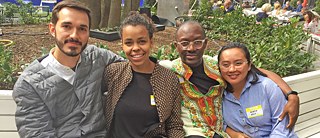Coding da Vinci Süd
Hack the Hackathon – Digitising Cultural Assets

For the cultural hackathon Coding da Vinci Süd, the Goethe-Institut invited 15 cultural professionals, coders and hackers from Brazil, Côte d’Ivoire, Indonesia, Senegal, South Africa and Tanzania to Munich.
Usually when you visit Gasteig, Munich’s largest library, you find people reading and, of course, it’s usually quiet. But this Sunday we see lots of people at many tables huddled together over laptops and talking animatedly. They’ve travelled here from countries like Brazil, Côte d’Ivoire, Indonesia, Senegal, South Africa and Tanzania for a cultural hackathon at the Coding da Vinci Süd kick-off weekend. In this programme, cultural professionals, coders and hackers are involved in the digitisation of cultural assets from art galleries, libraries, archives and museums.
A prerequisite for participation and digital literacy
Kofi Sika Latzoo is one of the participants. The creative strategist and designer from Senegal, who also works for the NASA Spaceapps Challenge Programme, is developing an app called Musel together in a team. With this application, tourists can find out about a city’s art treasures when booking a hotel. For example, during the booking process users are shown a painting about which they may request additional information. Their smartphone is networked with the TV in the hotel room on which guests can also view works of art in a larger format. “Book, pledge and be artsy” is the motto of the sophisticated app that Latzoo hopes to implement with his working group. The goal now is to find a hotel that will put the app on the market. Ignatia Nilu, a curator and author from Indonesia who works at Jogja National Museum is also taking part in Coding da Vinci Süd. She is spending two months in the Ebenböckhaus in Munich with the artist residency programme of the Cultural Department of the City of Munich. She’s interested in collaborative practices among artists, scholars, hackers and open technologies in contemporary art. At Coding da Vinci Süd, she and her team are developing an app about the history of postal services called Global Postmaster. For it, they are digitising the inventory of the Museum of Communication in Nuremberg so that users can interactively reconstruct historical post offices and expand their knowledge with quiz questions.
A few PDFs are no online strategy
Not all participants are designing apps. Leno Veras, curator and associate professor at the Universidade Federal in Rio de Janeiro, explains that the exchange of knowledge was enriching for him. “We are dealing with similar issues around the world: How can museums handle the huge amounts of data they possess, how can they create virtual platforms and how can solutions be found internationally for the transformation of museums in the digital era?” The participants were able to discuss digital strategies at the Museum Fünf Kontinente, the Lenbachhaus and the Bavarian Academy of Sciences. Johannesburg-based Molemo Moiloa is part of the Visual Arts Network of South Africa (VANSA) and is currently preparing for the founding of the Resistance and Liberation Movements Museum there. For the artist and curator, the discourse at some institutions in Bavaria is still quite conservative, for example when their only online strategy is to present PDFs on their websites. This gave the participants the opportunity to offer suggestions on how visitors can participate more, for example via network platforms and interactive formats. Moiloa’s project for Coding da Vinci Süd makes mathematical models of the University of Tübingen available on a website. She now has six weeks left to work with her colleagues from Germany and Brazil on it. Since Moiloa will be departing after the kick-off in Munich, the team will continue to work on the project virtually. On 18 May, the finished projects will be presented in Nuremberg. In 2020, the Goethe-Institut will be holding cultural hackathons in Brazil, Indonesia and one of the participating African countries after the Coding da Vinci model.